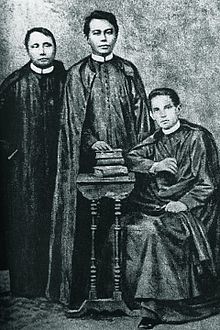GOMBURZA
GOMBURZA is an acronym composed of the first letters of the surnames of Filipino priests Mariano Gomez , Jose Burgos and Jacinto Zamora . All three are revered as national heroes in the Philippines .
The three priests were considered liberal free thinkers and campaigned for the modernization of the Spanish colony of the Philippines. All three were supporters of the secularization movement within the Catholic Church, which came from Spain to the Philippines in the 1850s and was strongly influenced by Pedro Pelaez . The three priests were appointed to the reform committee by the newly appointed governor of the Philippines, Joaquin Pardo de Taverain. The head of the group was considered to be Jose Burgos, who was known to the Archbishop of Manila, Gregorio Martinez. Mariano Gomez was a priest in Bacoor alongside his work in the commission and published articles in the newspaper La Verdad ( The Truth ), in which he repeatedly described the possibilities of modernization.
After the replacement of de la Torre by Rafael Izquierdo, a period of reactionary renewal began in which the reforms were reversed and z. B. the press censorship was reintroduced. The three priests were arrested in connection with the Cavite uprising of January 20, 1872 and sentenced to death on February 6. They were accused of being subversive. Since the files on the trial and the judgment of Spain have not been published to date, it is assumed that an example should be made of the three. The sentence was carried out on February 17th in Bagumbayan, today's Rizal Park in Manila, by the Garrotte . To protest against the execution, the Archbishop of Manila let the bells of the churches ring, which was disapproved by the Spanish monastic orders because they provided parts of the execution squad.
The execution met with incomprehension among the Filipino public. It then developed the movement of the Illustrados and the propaganda movement of Filipino students in Europe, which would eventually lead to the Liga Filipina and the Katipunan . A leading member of the propaganda movement was José Rizal , who erected a literary monument to the three priests in his work Noli me tangere ( Don't touch me ). The three have been considered martyrs since the Philippine Revolution (1896–1898). A memorial was erected to them at the place of their execution, in Rizal Park in Manila .
Web links
- Gomburza in Philippine History (English)
- Description of the Gomburza (English)
- Description of the Gomburza (English)

